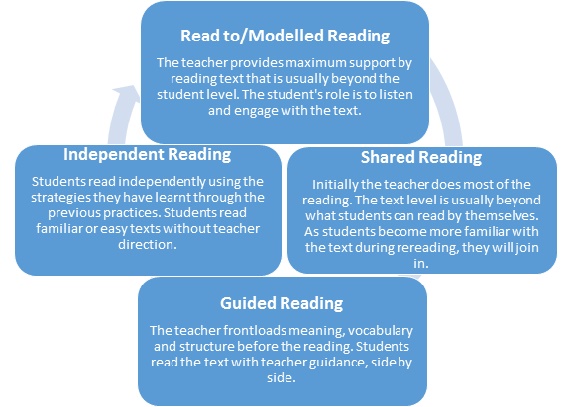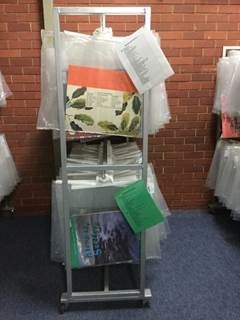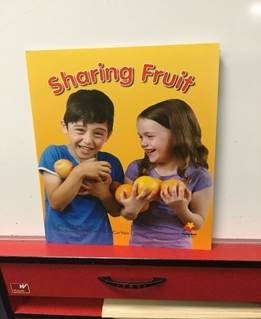Shared reading is an effective way for the teacher to demonstrate reading strategies and behaviours in continuous text.
 Shared reading is part of a suite of practices the teacher can use to support the teaching of reading. It is located at the higher end of teacher support in the Gradual Release Model (Duke and Pearson, 2002).
Shared reading is part of a suite of practices the teacher can use to support the teaching of reading. It is located at the higher end of teacher support in the Gradual Release Model (Duke and Pearson, 2002).
Initially, the focus of the reading is on meaning and enjoyment. Once understanding is established, the teacher can reread the text to explicitly demonstrate reading strategies and engage in problem solving using meaning, structure and visual information.
The importance of shared reading
 Shared reading usually involves the whole class and the teacher reading an enlarged text (for example, a big book, website projected via the interactive whiteboard or large-screen tv) that is beyond the level students can read by themselves.
Shared reading usually involves the whole class and the teacher reading an enlarged text (for example, a big book, website projected via the interactive whiteboard or large-screen tv) that is beyond the level students can read by themselves.
Big books are traditionally one of the more common shared reading text types as the text and illustrations are enlarged for student viewing.
The purpose of the enlarged text is so students can follow the words as the teacher reads. Initially the teacher may do much of the reading. However, as students become more familiar with the text they will assume more control, particularly at repetitive sections or when rhyme and rhythm are present.
 Students are expected to be actively engaged whilst the teacher is reading, following the text and when confident, joining in and reading with the teacher.
Students are expected to be actively engaged whilst the teacher is reading, following the text and when confident, joining in and reading with the teacher.
Shared reading provides opportunities for the teacher to:
Shared reading is a strategy that can support the teaching of the Big Six elements of reading:
- oral language
- early experiences with print
- phonological awareness
- phonics
- vocabulary
- fluency and comprehension.
Day one can focus on reading for meaning and enjoyment. Day two to five could focus on a rereading with explicit teaching based on the above elements.
Research
Research tells us that reading to children provides opportunities for them to:
- enjoy and engage with the pleasurable experience of reading. Furthermore, students who are engaged and motivated readers perform better on comprehension tasks (Cummings, 2007; Thomson, Hillman and De Bortoli, 2013) (See Literature: Description/Overview and Evidence Base).
- see and hear the complexities of language such as ‘book’ and technical vocabulary (Heath, 1983). This type of language, different to daily conversational language is what assists students to comprehend at deeper levels and think critically (Chall, Jacobs and Baldwin, 1990) (See:
Comprehension: Evidence Base).
- see and hear teachers explain the process of reading Identifying the problem solving (i.e. modelling, describing, explaining and scaffolding appropriate reading strategies) (Afflerbach, Pearson and Paris, 2008, p.370). This is important because students do not automatically know how to use reading strategies. Rather, students develop this knowledge after being apprenticed into this form of thinking (Rogoff, 1995; Vygotsky, 1978).
Theory to practice
Procedure
- select an enlarged text (print or web-based) that contains appropriate challenges and supports for students
- ensure all students can see the enlarged text
- discuss and establish students’ prior knowledge of the topic
- state the purpose of the text
- share the learning intentions and the success criteria with the students
- encourage students to predict the text from the cover, title, and illustrations
- encourage students to talk about the text and the language features of the text or
- identify and discuss with students the conventions of various text forms
- discuss meanings in texts relating them to their own experiences and
- model the use of information skills such as retrieving information from a text.
Using prompts
Shared Reading can be used to demonstrate how cue sources can be used through prompts for unknown words or masked words (i.e. strategically selected words that have been covered over for a teaching purpose).
Meaning prompts
Meaning prompts encourage readers to draw on their own knowledge and experiences as well as the storyline content and illustrations. To prompt for an unknown word the teacher would pause before reading the word and think aloud (for example, does the picture help me work out this word? what is happening in the story so far? what do I think is going to happen next?). After attempting the word, the teacher has another opportunity to think aloud, Does the word that I came up with make sense?
Structure prompts
Structure prompts encourage readers to use their knowledge of how language works and the structure of language and grammar to help them read an unknown word. The teacher would pause before they read the word and think aloud (for example, what would sound right there? I know the word has to be a verb, noun, adjective etc). After attempting the word, the teacher checks by asking, Can I say it that way in English?
Visual information
Visual information prompts encourage readers to focus on the word (letters, sounds, diagraphs, trigraphs, blends, onset/rime, prefixes, base word, suffixes, morphemes). To prompt for an unknown word, the teacher models their thinking aloud (efor example, what does the word start with? what sound does that letter(s) make? can I break the word into parts to help me?) After attempting the word, the teacher checks by asking themselves, Does that word look right?
Integrating more than one cue
Through shared reading the teacher can also cross-check one cue source with another to check accuracy. Again, this is an opportunity for the teacher to think aloud (for example, this word makes sense in the sentence but when I look at the first letter it does not match my guess. I will have to rethink).
Specific teaching using shared reading
Once students are familiar with the meaning of text, the teacher can explicitly demonstrate the main elements of reading.
Phonological awareness
Using examples from the shared text the teacher can:
- promote the development of rhythm, i.e. the rhythm of the English language is based on the syllable (Konza, 2016). Clapping in time to shared rhyming texts, songs and nursery rhymes can promote rhythm.
- promote the identification of and generation of rhyme teach onset and rime (See
Shared Reading lesson: blend and segment onset and rime)
- identify syllables in words (for example, each syllable must contain a vowel- al/pha/bet)
- teach how to isolate, blend, segment and manipulate sounds
Phonics
This strategy demonstrates how to decode new or unfamiliar words from the text through the demonstration of how to analyse letters, letter clusters (for example, blends, digraphs, trigraphs, rime, morphemes), word patterns and match to sounds
Using examples from the shared text the teacher can:
- explore words (for example, base words, prefixes, suffixes)
- investigate letter patterns that make the same sound (such as /ā/-baby, cake, say, snail, eight, they)
- find examples of singular and plurals, tense endings of regular and irregular verbs (i.e. looked, went), contractions (such as do not = don’t)
- explore compound words
- find and match high frequency words
For information, see:
Phonics
Vocabulary
Using examples from the shared text the teacher can:
- locate new and interesting words
- clarify the meaning of words
- find synonyms and antonyms of words in the text
- model how to use a dictionary, thesaurus or iPad to look up word meanings
- demonstrate how to work out the meaning of an unknown word using text clues
- investigate multiple meanings of a word (for example, crane = a type of bird, construction equipment used to lift heavy objects, a verb to describe the movement of your neck)
Fluency
Using examples from the shared text the teacher can:
- demonstrate reading at the appropriate rate (not too slow or too fast)
- demonstrate using prosody (for example, rhythm, phrasing and expression)
- identify punctuation and how it contributes to overall fluency (for example, pause at commas and full stops, inflect your voice at question marks, use the quotation marks to signal dialogue)
Comprehension
Using examples from the shared text the teacher can:
- teach comprehension strategies
- teach three levels of comprehension
For more information, see:
Comprehension
In practice examples
For in practice examples, see:
Shared reading lessons
References
Afflerbach, P., Pearson, P.D., and Paris, S.G. (2008). Clarifying Differences between Reading Skills and Reading Strategies, The Reading Teacher, Vol. 61, No. 5, pp.364-373
Chall, J., Jacobs, V., and Baldwin, L. (1990). The Reading Crisis: Why Poor Children Fall Behind. USA: Harvard University Press.
Cummings, J. (2007). Pedagogies for the Poor? Realigning Reading Instruction for Low-Income Students With Scientifically Based Reading Research, Educational Researcher, Vol. 36, No. 9, pp. 564-572
Duke, N.K. and Pearson, P.D. (2002). Effective reading practices for developing comprehension (Chapter 10), In A.E. Farstrup and S.J. Samuels (Eds.), What research has to say about reading instruction (3rd Ed.), Newark, DE: International Reading Association (pp. 205-242).
Heath, S.B. (1983). What no bedtime story means: Narrative skills at home and school, Language in Society, Vol. 11, No. 1, pp. 49-76.
Konza, D. (2016). Understanding the process of reading: The Big Six. In J.Scull and B. Raban (Eds.) Growing up literate: Australian literacy research for practice, (pp. 149-175). Hong Kong: Eleanor Curtain Publishing.
Nodelman, P. & Reimer, M. (2003). The pleasures of children’s literature. Boston: Allyn & Bacon.
Rogoff, B. (1995). Observing Sociocultural Activity on Three Planes: Participatory Appropriation, Guided Participation, and Apprenticeship, In J.V. Wertsch, P. Del Rio and A. Alvarez (Eds.), Sociocultural Studies of Mind, Cambridge: Cambridge University Press.
Thomson, S., Hillman, K. & De Bortoli, L. (2013). A teacher’s guide to PISA reading literacy. Camberwell, Vic: ACER.
Vygotsky, L.S. (1978). Mind in Society: The development of higher psychological processes. Cambridge, MA: Harvard University Press.